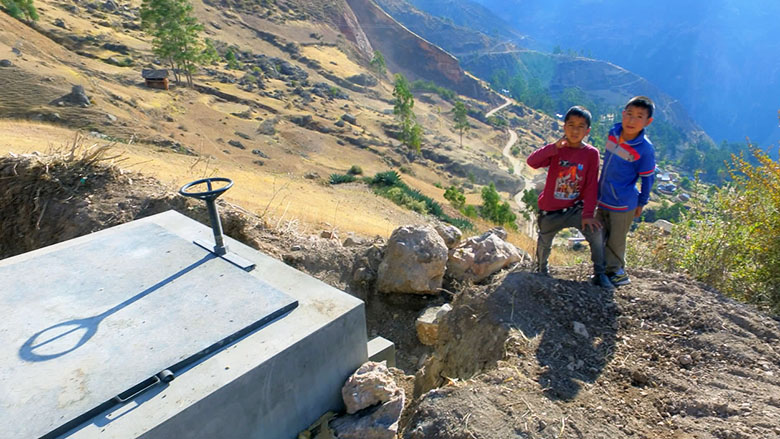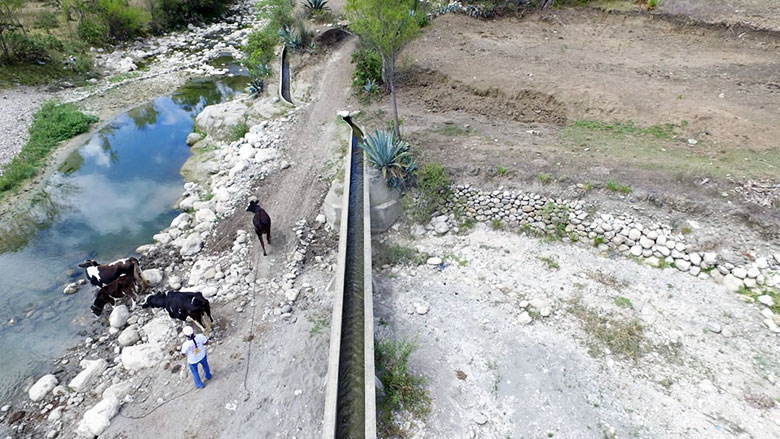Challenge
Although Peru had one of the best economic growth rates in Latin America, poverty in the Sierra was far above national averages, and considerably higher in rural areas, posing a challenge for the country’s economic sustainability. The 2002 Household Survey indicated that the incidence of poverty in the rural Sierra was about 75 percent (4.2 million people), with more than 40 percent of the population (2.3 million people) characterized as extremely poor.
In 2010, the largest share of household income in the Sierra came from agriculture. About 400,000 hectares of agricultural land was irrigated, representing a third of the total irrigated area in the country. However, the sector faced many challenges. Irrigation systems, usually small, were supplied mostly from surface water sources and consisted of a network of open canals, generally unlined, with rudimentary water intakes and distribution systems. Irrigation systems generally did not include water regulation structures. Less than 5 percent of the irrigated area was equipped with improved on-farm irrigation systems, leading to low efficiencies at the farm level. Management of irrigation infrastructure was also weak. Because the government and donors had traditionally focused support on Peru’s coastal area, only a small number of water user organizations (WUOs) in the Sierra had received capacity building and infrastructure investments, and those investments had been very limited. In general, the Sierra WUOs were financially and technically weak, with low water tariffs and collection rates. Consequently, planning or daily management of water distribution and irrigation services were negligible or nonexistent. Poor maintenance contributed to the gradual degradation of the infrastructure and poor water delivery performance, thus limiting water quantity, frequency, and reliability at the field level.
Problems of low quantity, uniformity, frequency, and reliability of irrigation delivery to crops thus often persisted, even in irrigated areas. Many areas of the Sierra, required improvements in irrigation infrastructure and management to increase the value of agricultural production and to foster production of higher-value crops for internal and export markets.
Approach
The goal of the Peru Sierra Irrigation Subsector Project was to increase and improve agricultural performance in the Sierra by improving irrigation technology, thus providing farmers with enough water to secure traditional harvests and, over time, to shift to higher export-value crops. The project included four components: (i) modernization and rehabilitation of collective irrigation, aimed at financing pre-investment studies and design, execution, and supervision of subprojects to support eligible WUOs in improving their water supply service to farmers through modernization or rehabilitation of collective irrigation systems; (ii) irrigation technology improvement, aimed at financing pre-investment studies and design, execution, and supervision of subprojects to support eligible farmers’ groups and increase irrigation performance at the farm level through improved on-farm irrigation systems; (iii) capacity building and support to production and marketing, aimed at supporting capacity building of the water users’ organizations and of agricultural producers and business groups; and (iv) formalization of water rights and the national water rights administrative registry, aimed at providing technical assistance and equipment to formalize and issue water licenses and expand the Water Use Rights Registry.
Results
The Peru Sierra Irrigation Subsector Project made a significant contribution to increasing agricultural production and productivity in targeted areas of the Peruvian Sierra. It was successful in increasing irrigation water flow and frequency (28 percent on average) and irrigation efficiency (72 percent compared to 22 percent). Improved irrigation led to crop intensification in the project- intervened areas, ranging between 118 percent and 170 percent, with many farmers switching to higher-market-value crops.
- From 2011 to 2016, efforts to modernize and rehabilitate collective irrigation systems helped 75 sub-WUOs (in 12 WUOs) to improve irrigation service delivery to 18,758 farmers irrigating 14,770 hectares.
- Capacity building was provided in each of the 12 selected WUOs and supporting sub-WUOs to achieve eligibility investments and to formulate operation and maintenance (O&M) plans to improve water services delivery. Seventy-five WUOs were trained, formulated O&M plans, and implemented related management tools. A total of 59 WUOs (79 percent of the selected WUOs) were satisfactorily implementing their O&M plans at the end of the project.
- A significant benefit of these trainings was an increase in water tariffs collection. The percentage of farmers who paid water tariffs to their WUOs increased from 50 percent to 80 percent between 2011 and 2016. The total amount collected went from S/. 1.52 million to S/. 2.22 million during the same period, improving the financial capacity of WUOs and sub-WUOs.
- Approximately 1,680 farmers benefited from on-farm irrigation systems covering 1,969 hectares. As a result, an important percentage of these farmers, in almost all WUOs, changed to high-value crops. On-farm irrigation improvements also brought increases in crop intensification in all monitored parcels.
- Trainings strengthened the capacity of agricultural producers and business groups. A total of 1,506 farmers were trained and 110 business plans were satisfactorily implemented. The improved irrigation systems led to increased irrigation efficiency in all benefited areas.
- The agricultural yields of several crops in the intervention areas increased (as compared to the control group); for example, among other crops tracked, the rye grass yield rose 100 percent, the potato yield 67 percent and the maize yield 27 to 177 percent.


